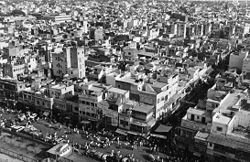History of Delhi
The new city of delhi was aquised under Land and Aquisition Act to download Land and acquisition Act click here . The agreement of construction of new city of delhi with original sigs of herbert baker & edwin luteyns is avaialable here
| Historical Region of North India Delhi | |||||||||
| Location | Delhi | ||||||||
| State established: | 736 AD | ||||||||
| Language | Khariboli, Hindi, Urdu | ||||||||
| Dynasties | Tomaras-Chauhans (736-1192) Mamluk (1206–1289) Khilji (1290–1320) Tughlaqs (1320–1413) Sayyids (1414–51) Lodis (1451–1526) Mughals (1526–1540) Suris(1540-1553) Hindu-Hemu(1553–56) Mughals(1556-1857) British (1857–1947) Independence (1947-) | ||||||||
| Historical Capitals | Indraprastha
Lal Kot (Rai Pithora) Mehrauli Siri Tughlaqabad Jahanpanah Ferozabad (Feroz Shah Kotla) Dinpanah (Shergarh, Purana Qila, Old Fort) Lodi complex Shahjahanabad (Puraani Dilli, Old Delhi) | ||||||||
The Indian capital city of Delhi has a long history, including a history as the capital of several empires. The earliest architectural relics date back to the Maurya Period (c. 300 BC); since then, the site has seen continuous settlement. In 1966, an inscription of the Mauryan Emperor Ashoka (273-236 BC) was discovered near Srinivaspur. Two sandstone pillars inscribed with the edicts of Ashoka were brought to by Firuz Shah Tughluq in the 14th century. The famous Iron pillar near the Qutub Minar was commissioned by the emperor Kumara Gupta I of the Gupta dynasty (320-540) and transplant Delhi during the 10th century. Eight major cities have been situated in the Delhi area. The first five cities were in the southern part of present-day Delhi.
Though settlements have been dated to have been in existence in Delhi for millennia, there is no record to stand by that claim. Delhi is generally considered a close to 5000-year old city, as per Ancient Indian text The Mahabharata, since the first ever mention of the city is found in this religious scripture. Therefore, except the scripture and some related heritage like the Yogmaya Temple, archaeological evidences to book the city's Ancient history are as good as naught. As a result, Delhi's Ancient history finds no records and this period may be regarded as the lost period of its history. Extensive coverage of Delhi's history begins with the onset of the Delhi Sultanate in the 12th century. Since then, Delhi had been the seat of Islamic and British rulers until India's independence in 1947.
The core of Delhi's tangible heritage is Hindu, Islamic, spanning over seven centuries of Islamic rule over the city, with some British-styled architectures and zones in Lutyens' Delhi dating to the British rule in India. Whatever records exist of Delhi- in the form of scriptures or archaeological evidences, they crown Delhi as the Capital city of some empire or the other all through, with minor random breaks in between, making Delhi one of the longest serving Capitals and one of the oldest inhabited cities in the world.[1][2] It is considered to be a city built, destroyed and rebuilt several times, as outsiders who successfully invaded the Indian Subcontinent would ransack the existing capital city in Delhi, and those who came to conquer and stay would be so impressed by the city's strategic location as to make it their capital and rebuild it in their own way.[3][4]
Cities of Delhi

The modern city contains the remnants of at least 11 Capital cities including:
- The first instance of the region being capitalised was in the Ancient Era, during the time of the Mahabharata War,more than 5000 years back, when the five Pandava brothers built an immense and highly sophisticated fortress called Indraprastha and ruled the country from there.
- 'Dhili' was founded by the Tomara ruler, Anangpal according to Vibudh Shridhar and other later authors.[5] Lal Kot built by the Tomar was renamed Qila Rai Pithora after Prithvi Raj Chauhan (also known as Rai Pithora). It was a thirteen-gated fort in Delhi. Prithviraj, a Chauhan king, was the second-to-last Hindu king of Delhi.
- Mehrauli, built by Qutubuddin Aibak in the 12th century;
- Siri, built by Alauddin Khalji in 1303;
- Tughluqabad, built by Ghiyasuddin Tughluq (1321–1325);
- Jahanpanah, built by Muhammad bin Tughluq (1325–1351);
- Ferozabad, built by Firuz Shah Tughluq (1351–1388);
- Dinpanah built by Humayun and Shergarh built by Sher Shah Suri, both in the area near the speculated site of the legendary Indraprastha (1538–1545);
- Lodi Complex, built by the Lodi rulers and the least significant of all the dynasties of Delhi Sultanate (1451–1526); and
- Shahjahanabad, the walled city built by Shah Jahan from 1638 to 1649, containing the Lal Qila and the Chandni Chowk. It was the capital of the Mughal Empire during Shah Jahan's reign. It is presently referred to as "Old Delhi".
- Lutyens' Delhi or New Delhi, the city built by the British on the south-west, declared Capital on 12 December 1911.
- The region of Hauz Khas in South Delhi is a part of two cities, viz. Siri and Ferozabad, of Delhi. While the Hauz Khas Lake is a part of the former, the tombs and the monuments surrounding it belong to the latter.
Modern Delhi, referred to as 'Dilli' locally, derived from its historical name Dhili, is an amalgam all of the above.
There are texts that mention Delhi as a cluster of more than 11 cities. This is quite possible, given Delhi's long history as a capital, but reliable records regarding the same do not exist. Officially, however, only seven of the above-mentioned eleven cities are recognized.[6] The official recognition cites distinct identity and indigenous heritage for a historical city to be recognized as a City of Delhi. Of the above-mentioned eleven Cities of Delhi, the officially recognized seven cities are Qila Rai Pithora, Mehrauli, Siri, Tughlaqabad, Ferozabad, Dinpanah and Shahjahanabad.
The rest are not officially identified as Cities of Delhi because of some specific reasons.
- Indraprastha, the legendary Ancient City is believed to have been established 5000 years ago (c. 2800 BC), as per the ancient Indian text- the Mahabharata. Though very much a part of India's very Ancient history, it lacks any tangible evidence to say without doubt that it existed. Archaeological evidence exists, but in such scarcity as be inconclusive. As acknowledged by British historian Michael Wood in his BBC documentary The Story of India,[7] the excavated ceramic pottery from the site of today's Purana Qila in Delhi and the excavated layers of the ancient city seem to match what the verses of the Mahabharata indicate. More possible evidence in its favour is the existence of a village named Indraprastha very close to the Purana Qila that was destroyed by the British during the construction of Lutyens' Delhi.[8]
- Jahanpanah is not considered as a City of Delhi because it is very much in ruins and too diffused now to be considered a distinct city. Moreover, sections of the city still standing are now counted in Siri or Mehrauli.
- Lodi Complex is not counted as a distinct city because their architectures are too few to be counted as a whole city. The Sayyid and Lodhi dynasties that followed the Tughlak dynasty were far more concerned with restoring stability than patronisation of arts or architecture. Tombs erected in the honour of the rulers are the only monuments of these times and these are scattered all over current South and Central Delhis.[9]
- New Delhi, the Capital city of modern India is also not counted as a City of Delhi because the structures of those times are still in use as government buildings. So there seems no such thing as "history" about it. On 12 December 2011 New Delhi celebrated 100 years of serving as India's National Capital.[10]
Early history

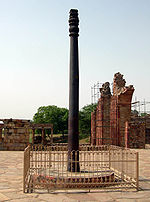
According to Indian folklore, Delhi was the site of the magnificent and opulent Indraprastha, capital of the Pandavas in the Indian epic Mahabharata, founded around 3500 BC. It was, one of the five prasthas or `plains', which included Sonepat, Panipat, Tilpat (near Faridabad), and Baghpat.[13] 16th-century, Persian historian, Firishta, recorded a tradition that Delhi or Dilli was founded by a Raja Dhilu before the Yavana (Greek) invasions. However, it should be noted that the kings then referred to the initial Muslim invaders as Yavanas.[13]
Hindu texts state that the city of Delhi used to be referred to in Sanskrit as Hastinapur, which means "elephant-city". The name Delhi may be derived from the word 'Dhillika', though there are other theories. According to Satyarth Prakash (1874) of Swami Dayanand, Raja Dhilu (King Dihlu) founded ancient Delhi in 800 BC, however it is not supported by any older texts[14] It was the name of the first medieval township of Delhi, located on the southwestern border of the present Delhi, in Mehrauli. This was the first in the series of seven medieval cities. It is also known as Yoginipura, that is, the fortress of the yoginis (female divinities). It gained importance during the time of Ananga Pala Tomar. In the 12th century, the city was included in the dominions of Prithviraj Chauhan.
Pasanaha Chariu of Vibudh Shridhar (VS 1189-1230) an Apabhramsha writer, provides the first reference to the legend of the origin of the name Dhilli for Delhi.[5]
हरियाणए देसे असंखगाम, गामियण जणि अणवरथ काम|
परचक्क विहट्टणु सिरिसंघट्टणु, जो सुरव इणा परिगणियं|
रिउ रुहिरावट्टणु बिउलु पवट्टणु, ढिल्ली नामेण जि भणियं|
Translation: There are countless villages in Haryana country. The villagers there work hard. They don't accept domination of others, and are experts in making the blood of their enemies flow. Indra himself praises this country. The capital of this country is Dhilli.
जहिं असिवर तोडिय रिउ कवालु, णरणाहु पसिद्धउ अणंगवालु ||
वलभर कम्पाविउ णायरायु, माणिणियण मणसंजनीय ||
Translation: The ruler Anangapal is famous, he can slay his enemies with his sword. The weight (of the Iron pillar) caused the Nagaraj to shake.
A VS 1383 inscription in Delhi Museum confirms the founding of Delhi by the Tomars:
देशोऽस्ति हरियानाख्यो पॄथिव्यां स्वर्गसन्निभः |
ढिल्लिकाख्या पुरी तत्र तोमरैरस्ति निर्मिता ||
Prithviraj Raso also confirms the founding by the Tomars and the legend of the loose nail:
हुं गड्डि गयौ किल्ली सज्जीव हल्लाय करी ढिल्ली सईव |
फिरि व्यास कहै सुनि अनंगराइ भवितव्य बात मेटी न जाइ ||
8th century to 16th century
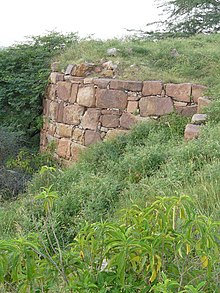
(Village Anangpur, a Gurjar village is not far away from Rai Pithora)
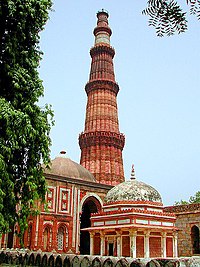
The Tomar dynasty founded Lal Kot in 736. The Prithviraj Raso names the Tomar Anangpal as the founder of Lal Kot, whose name is inscribed on Iron Pillar of Delhi at Qutb complex, ascribed to Chandra or Chandragupta II.[15]
The Chauhan kings of Ajmer conquered Lal Kot in 1180 and renamed it Qila Rai Pithora.

The Chauhan king Prithviraj III was defeated in 1192 by the Muslim invader Muhammad Ghori. Anangpal Tomar, who, according to historian Augustus Hoernle, was a Gurjar[16] ruler of Delhi, often described as the founder of Delhi, built the citadel some 10 kilometres from Suraj Kund around 731.
From 1206, Delhi became the capital of the Delhi Sultanate under the Slave Dynasty. The first Sultan of Delhi, Qutb-ud-din Aybak, was a former slave who rose through the ranks to become a general, a governor and then Sultan of Delhi. Qutb-ud-din started the construction of the Qutub Minar, a recognisable symbol of Delhi, to commemorate his victory but died before its completion. In the Qutb complex he also constructed the Quwwat-al-Islam (might of Islam), which is the earliest extant mosque in India. He was said to have destroyed twenty-seven Jain temples initially housed in the Qutb complex and pillaged exquisitely carved pillars and building material from their debris for this mosque, many of which can still be seen.[17] After the end of its the Slave dynasty, a succession of Turkic Central Asian and Afghan dynasties, the Khilji dynasty, the Tughluq dynasty, the Sayyid dynasty and the Lodi dynasty held power in the late medieval period and built a sequence of forts and townships in Delhi.[18]
In 1398, Timur Lang invaded India on the pretext that the Muslim sultans of Delhi were too tolerant of their Hindu subjects. After defeating the armies of Nasiruddin Mahmud of Tughlaq dynasty, on 15 December 1398, Timur entered Delhi on 18 December 1398, and the city was sacked, destroyed, and left in ruins, and over 100,000 war prisoners were killed as well.[19][20] In 1526, following the First Battle of Panipat, Zahiruddin Babur, the former ruler of Fergana, defeated the last Afghan Lodi sultan and founded the Mughal dynasty which ruled from Delhi, Agra and Lahore.
16th century to 19th century

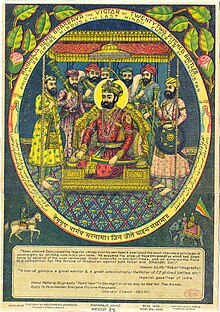

In the mid-16th century there was an interruption in the Mughal rule of India as Sher Shah Suri defeated Babur's son Humayun and forced him to flee to Persia. Sher Shah Suri built the sixth city of Delhi, as well as the old fort known as Purana Qila, even though this city was settled since the ancient era. After Sher Shah Suri’s death in 1545, his son Islam Shah took the reins of north India from Delhi. Islam Shah ruled from Delhi till 1553 when Hindu king Hem Chandra Vikramaditya, also called Hemu, became the Prime Minister and Chief of Army of Adil Shah. Hem Chandra fought and won 22 battles in all against rebels and twice against Akbar's army in Agra and Delhi, without losing any. After defeating Akbar's army on 7 October 1556 at Tughlakabad fort area, Hemu acceded to Delhi throne and established Hindu Raj in North India for a brief period, and was bestowed with the title 'Samrat Hem Chandra Vikramaditya', at his coronation in Purana Quila, Delhi.
The third and greatest Mughal emperor, Akbar, moved the capital to Agra, resulting in a decline in the fortunes of Delhi. In the mid-17th century, the Mughal Emperor Shah Jahan (1628–1658) built the city that sometimes bears his name Shahjahanabad, the seventh city of Delhi that is more commonly known as the old city or old Delhi. This city contains a number of significant architectural features, including the Red Fort (Lal Qila) and the Jama Masjid. The old city served as the capital of the later Mughal Empire from 1638 onwards, when Shah Jahan transferred the capital back from Agra. Aurangzeb (1658–1707) crowned himself as emperor in Delhi in 1658 at the Shalimar garden ('Aizzabad-Bagh) with a second coronation in 1659. After 1680, the Mughal Empire's influence declined rapidly as the Hindu Maratha Empire rose to prominence.[21]
In 1737, Maratha forces sacked Delhi, following their victory against the Mughals in the First Battle of Delhi. In 1739, the Mughal Empire lost the huge Battle of Karnal in less than three hours against the numerically outnumbered but military superior Persian army led by Nader Shah of Persia during his invasion after which he completely sacked and looted Delhi, the Mughal capital, carrying away immense wealth including the Peacock Throne, the Daria-i-Noor, and Koh-i-Noor. The Mughals, severely further weakened, would never overcome this crushing defeat and humiliation which would also let the way open for more invaders to come, including eventually the British.[22][23][24] Nader eventually agreed to leave the city and India after forcing the Mughal emperor Muhammad Shah I to beg him for mercy and granting him the keys of the city and the royal treasury.[25] A treaty signed in 1752 made Marathas the protector of the Mughal throne at Delhi.[26] In January 1757, Abdali invaded Delhi. He returned to Afghanistan in April 1757 giving the control of Delhi to Najib-ud-Daula. However, Marathas occupied Delhi after defeating Najib in a siege of the city. In 1761, the Marathas lost Delhi as a consequence of the third battle of Panipat, the city was again raided by Abdali.
In early 1771, ten years after the collapse of Maratha supremacy in north India in the Third Battle of Panipat, Marathas under Mahadji Shinde recaptured Delhi and restored the Mughal king Shah Alam II as a titular head to the throne in 1772.
In 1803, during the Second Anglo-Maratha War, the forces of British East India Company defeated the Maratha forces in the Battle of Delhi, ending the Maratha rule over the city.[27] As a result, Delhi came under the control of British East India Company. Between 1836 and 1858, Delhi was a part of what then known as the North-Western Provinces.
Delhi passed into the direct control of British Government in 1857 after the First War of Indian Independence. The city received significant damage during the 1857 siege. Afterwards, the last titular Mughal Emperor Bahadur Shah Zafar II was exiled to Rangoon and the remaining Mughal territories were annexed as a part of British India.


Calcutta was declared the capital of British India but in 1911 at the Delhi Durbar of 1911, held at the Coronation Park, King George V announced the shifting of the capital back to Delhi. Parts of the old city were New Delhi, a monumental new quarter of the city designed by the British architect Edwin Lutyens to house the government buildings was inaugurated in 1931 after its construction was delayed due to World War I.[28] New Delhi was officially declared as the seat of the Government of India after independence in 1949. During the Partition of India thousands of Hindu and Sikh refugees from West Punjab migrated to Delhi, and subsequently settled in North and West Delhi areas, while Hindus from East Pakistan, settled in the late 1960s at EPDP Colony (EPDP: East Pakistan Displaced Persons) in South Delhi, later named Chittaranjan Park in the 1980s.
Further reading
- Hartcourt, A., Assistant Commissioner Delhi (1873). The New guide to Delhi. Lahore, Victoria Press.
{{cite book}}: CS1 maint: multiple names: authors list (link) - Fanshawe, H. C. (1902). Delhi - Past and Present. London, J. Murray.
- Fraser, Lovat (1903). At Delhi (An account of the Delhi Durbar, 1903). Bombay : Times of India Press and Thacker.
- Bardiar, Nilendra. Urban, Cultural, Economic and Social Transformation: History of New Delhi 1947-65). New Delhi, Ruby Press & Co.
- Hearn, Gordon Risley (1906). The Seven Cities of Delhi. W. Thacker & Co., London.
See also
References
- ^ [1]
- ^ List of cities by time of continuous habitation#Central and South Asia
- ^ [2]
- ^ [3]
- ^ a b An Early Attestation of the Toponym Ḍhillī, by Richard J. Cohen, Journal of the American Oriental Society, 1989, p. 513-519
- ^ Seven Cities of Delhi
- ^ Indraprastha did exist! The Mahabharata is a reality!- British historian Michael Wood
- ^ Indraprastha Village
- ^ Why Lodi Complex isn't counted as a distinct city?
- ^ New Delhi celebrates 100 years
- ^ Balasubramaniam, R. 2002
- ^ Arnold Silcock; Maxwell Ayrton (2003). Wrought iron and its decorative use: with 241 illustrations (reprint ed.). Mineola, N.Y: Dover. p. 4. ISBN 0-486-42326-3.
{{cite book}}: CS1 maint: multiple names: authors list (link) - ^ a b Gazetter, p. 233
- ^ Satyarth Prakash-Swami Dayananda Saraswati.
- ^ Ghosh, A. (1991). Encyclopedia of Indian Archaeology. BRILL. p. 251. ISBN 90-04-09264-1.
{{cite book}}: External link in|ref= - ^ A. F. Rudolf Hoernle. Some Problems of Ancient Indian History. No. III: The Gurjara Clans(Concluded from p. 662, October, 1904). The Journal of the Royal Asiatic Society of Great Britain and Ireland, (Jan., 1905), pp. 1-32. JSTOR 25208724.
Both this "leader" and the "lord" Rudrena must have been chiefs of minor divisions of the imperial Tomara clan of Gurjaras.
- ^ "World Heritage Monuments and Related Edifices in India". Pg.107. Google Books. Retrieved 27 May 2009.
{{cite web}}:|first=missing|last=(help)CS1 maint: multiple names: authors list (link) - ^ Battuta's Travels: Delhi, capital of Muslim India
- ^ The Islamic World to 1600: The Mongol Invasions (The Timurid Empire)
- ^ Hunter, Sir William Wilson (1909). "The Indian Empire: Timur's invasion 1398". The Imperial Gazetteer of India. Vol. 2. p. 366.
- ^ Thomas, Amelia. Rajasthan, Delhi and Agra. Lonely Planet. ISBN 978-1-74104-690-8.
- ^ Later Mughal. Retrieved 2 June 2014.
- ^ Territories and States of India. Retrieved 2 June 2014.
- ^ "Iran in the Age of the Raj". Avalanchepress.com. Retrieved 11 March 2011.
- ^ Soul and Structure of Governance in India. Retrieved 2 June 2014.
- ^ Gordon, Stewart. The Marathas 1600–1818, Volume 2. Cambridge University Press, 1993. ISBN 978-0-521-26883-7.
- ^ Mayaram, Shail. Against history, against state: counterperspectives from the margins Cultures of history. Columbia University Press, 2003. ISBN 978-0-231-12731-8.
- ^ A brief but fascinating account of the Indian contractors behind this constructed a Little Malice.
Bibliography
- "History of Delhi District". [[The Imperial Gazetteer of India]], Vol. 11. Oxford at Clarendon Press. 1909. p. 225.
{{cite book}}: URL–wikilink conflict (help) - Kapoor, Pramod; Malvika Singh; Rudrangshu Mukherjee (2009). New Delhi: Making of a Capital. Lustre Press. ISBN 978-81-7436-574-3.
- Byron, Robert (1931). New Delhi. The Architectural Review, Westminster.
External links
- Delhi (1938), a documentary by BFI archives
- "Scenes from Delhi (Silent film, 18:16 - 23.27)". University of Pennsylvania Museum of Archaeology and Anthropology Films. c. 1930.

